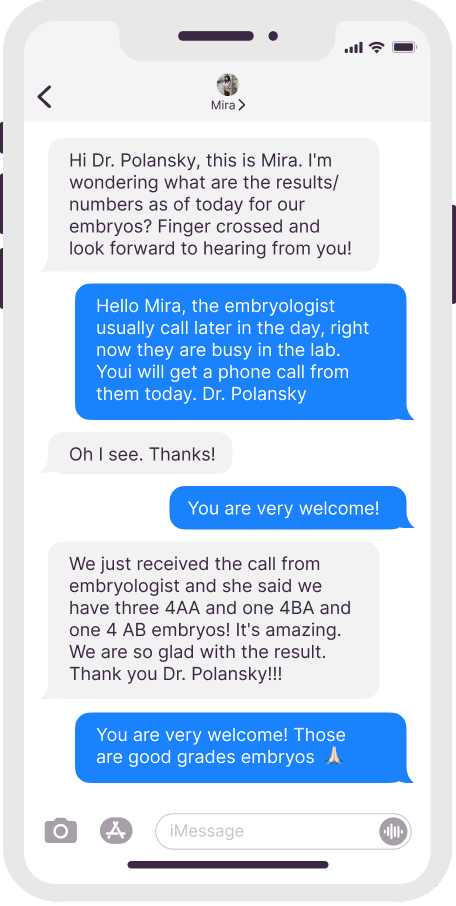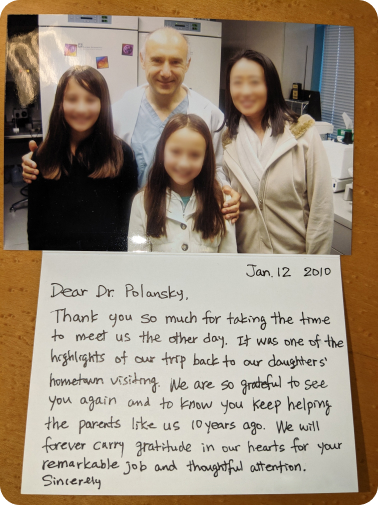


Is It Time to Consider IVF?
In Vitro Fertilization treatment has been successfully used for a wide variety of infertility conditions


You have “tried” too long
There is no distinction between having unprotected intercourse and “trying” to conceive. They both represent “exposure” to conception. With each passing cycle without a pregnancy, the probability of conception rapidly decreases.
A young couple who just stopped using contraception has a 20% to 25% likelihood of conception during the first cycle (month) of “exposure.” After a year, during the 13th month, the probability decreases to approximately 1.5%. After two years, it becomes approximately 0.1% (1 out of 1,000 couples) during the next cycle.
Based on the length of infertility alone, most patients should consider IVF treatment after a year and a half to two years of infertility.
Advancing age of the female partner
For most women, their fertility peaks in their mid-twenties. Starting around the age of 32, the quality of the remaining eggs within the ovaries begins to decline. By the age of 39, for most women, the quality of their remaining eggs will make it difficult or even impossible to conceive on their own or with “low tech” (oral medications, IUIs, etc.) fertility treatments.
Based on the female age alone, most patients should consider IVF treatment once they reach the age of 37. Most women older than 43 will require Donor Egg IVF to conceive successfully.
Male infertility
It is estimated that approximately 10% to 15% of all men are born with some degree of male infertility, and nearly one-third of the time, a couple’s infertility can be solely attributed to male factor infertility.
For most men, there is no completely reliable test to assess male fertility. Diagnosing male infertility is often facilitated by excluding all possible female infertility factors.
Most couples diagnosed with male infertility will either be lucky and conceive on their own or will require In Vitro Fertilization. Intrauterine insemination (IUI) is typically no more effective than intercourse for male factor infertility.
Pelvic adhesions
In the past, pelvic adhesions (scars) and blockages of the Fallopian tubes used to be treated surgically (laparoscopy, laparotomy). Many such surgeries were unsuccessful, and there is an increased risk of an ectopic (tubal) pregnancy afterward.
In Vitro Fertilization is now considered to be the most appropriate treatment for pelvic adhesions and tubal blockages.
Endometriosis
There is a lack of consistent scientific evidence that surgical or medical removal of endometriosis increases the probability of pregnancy. This has led some clinicians to believe that endometriosis is merely a sign of another underlining cause of infertility.
The most appropriate treatment for endometriosis depends on the underlying cause and the length of infertility. If you are 39 or younger (female partner) and have been sexually active without contraception for 18 months or more, you may need In Vitro Fertilization to conceive. Women 39 years and older should consider IVF treatment after only three months of no contraception.
Polycystic Ovary Syndrome (PCOS)
Polycystic ovaries are by far the most common cause of irregular menstrual periods and the lack of ovulation (anovulation).
The term “polycystic” refers to the increased number of ovarian follicles (not cysts) present within the ovaries of most women with PCOS.
In Vitro Fertilization is the recommended treatment for women with moderate and moderately severe degrees of PCOS. It allows for precise modulation of ovarian stimulation and minimizes the risk of multiple pregnancy by limiting the number of transferred embryos.
Multiple miscarriages
In Vitro Fertilization, possibly with the addition of preimplantation embryo genetic testing (PGT), may be considered by patients with a history of recurrent miscarriages (three or more).
Unsuccessful ovarian stimulation and IUIs
If such treatment is recommended, there should be no more than 3 to 6 ovarian stimulation cycles with oral medications with or without intrauterine inseminations. In Vitro Fertilization should be considered a better alternative if this treatment is unsuccessful.
Unexplained infertility
Up to 25% of all infertile patients will be diagnosed with unexplained (idiopathic) infertility. This diagnosis means that, in spite of exhaustive fertility evaluation, there is no apparent cause of infertility.
Most of these patients have infertility factor(s) involving the eggs, sperm, and Fallopian tubes, but their testing has not uncovered this information. Infertility related to the egg quality factor represents the most “unexplained” infertility since it is the most difficult to diagnose.
In Vitro Fertilization is the most common treatment for patients with unexplained infertility.

We look forward to meeting you at Bay IVF and, when your treatment is successful, celebrating your new pregnancy!
 +
+Years of Experience
 +
+Babies Born
 %
%Compassionate Care


Hear from Our Patients’ Journey to Parenthood at Bay IVF!

I would highly recommend Bay IVF for those wanting to build their family and needing IVF support! Dr. Polansky and the whole Bay IVF team were so supportive and welcoming while also honest and realistic. Our girl is our dream come true!
Jennifer C.-F.This clinic has been amazing to work with. All the nurses and staff made sure I was always comfortable and were there to answer questions any time I needed. We are incredibly grateful to Dr. Polansky and the team for everything they did for us.
Harpreet K.Words could never express the gratitude my husband and I will always have for Bay IVF! We did our research and decided to check out Bay IVF. We scheduled a consultation and felt an instant connection… love at first sight!
Chelsea L.
Bay IVF Early Pregnancy Heartbeat

Meet Your Doctor

- Dr. Polansky received his medical diploma from Charles University in Prague, the Czech Republic, in 1978.
- After completing his OB/GYN residency at Jewish Hospital in Saint Louis, MO, he graduated from the Reproductive Endocrinology and Infertility (REI) fellowship at Stanford University in 1985.
- In the same year, he co-founded the Stanford IVF Clinic.
- Dr. Polansky obtained board certification in Obstetrics and Gynecology in 1986 and became REI subspecialty board certified in 1988.
- In 1987, he left Stanford University and established Nova IVF.
- In 2011, he founded Bay IVF, where he provides advanced fertility treatments with a holistic approach, utilizing state-of-the-art techniques.
- Dr. Polansky personally performs ultrasound examinations, egg retrievals, embryo transfers, and ovarian and endometrial stimulations for his patients.
- He is deeply committed to his patients and freely shares his cell phone number, ensuring accessibility and availability 24/7.
Frank Polansky, M.D.

Dr. Polansky’s Communication With Patients
Real texts, anonymous patient names












Initial Appointment Questions
When you call to schedule your consultation, Erica will ask you a short series of questions regarding your reproductive history.
Patients’ Thank You Cards


















Your Initial Visit at Bay IVF
Attending a new patient appointment at a fertility clinic can be stressful. Our primary objective is to ensure that your initial visit is friendly and relaxing. We encourage you to ask questions at every step of the process.

1 — When You Arrive
You will be welcomed by one of the clinic receptionists. One of our nurses will measure your height and weight and take your blood pressure

2 — Meet Your Doctor
Dr. Polansky will ask you a series of clarifying questions and then provide you with a summary of the factors contributing to your infertility

4 — Exam Room
One of the nurses will escort you to an examination room. Your examination will begin with listening to your lungs and heart

3 — Ask Your Questions
You will then have a discussion with him about the most suitable reproductive treatment(s) for you. During this time, you will have the opportunity to ask any questions you may have

5 — Ultrasound of the Ovaries
The next step is a pelvic ultrasound to examine the uterus and ovaries. This ultrasound will help determine the number of antral follicles present within the ovaries

6 — Financial Part
Following that, you will have a discussion with one of the financial advisors regarding the financial aspects of your treatment, including potential treatment financing options

8 — Support 24/7
If you have any questions after leaving the clinic, please feel free to reach out to us via phone call, text, or email. Open and discreet communication is an integral part of the care we provide at Bay IVF

7 — What About Time?
Your entire visit is expected to last approximately one hour


Schedule Your Initial Consultation With Dr. Polansky
Online or In-Person
You can also complete the form below to request your initial consultation


Still Have Questions?
We know this is a big decision. It is important for us that you feel really comfortable.







